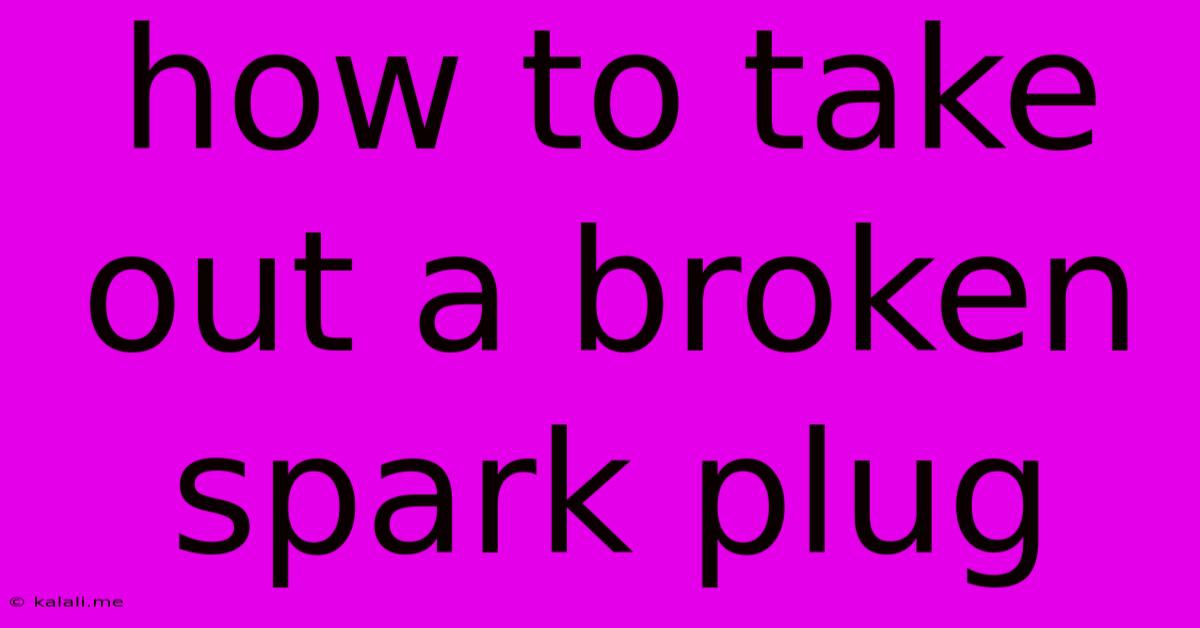How To Take Out A Broken Spark Plug
Kalali
Jun 10, 2025 · 3 min read

Table of Contents
How to Remove a Broken Spark Plug: A Step-by-Step Guide
Removing a broken spark plug can be a frustrating experience, but with the right tools and techniques, you can successfully extract it without causing further damage to your engine. This guide provides a comprehensive approach, covering various scenarios and offering solutions for different levels of breakage. This process requires patience and precision; rushing could worsen the situation.
What you'll need:
- Spark plug socket: A quality socket specifically designed for spark plugs, ideally with a built-in rubber insert to grip the plug securely. Avoid using a worn or damaged socket.
- Wrench: Choose a wrench that fits your spark plug socket snugly. A ratchet wrench is often preferred for better leverage and control.
- Penetrating oil (PB Blaster or similar): This helps loosen the corroded threads of a stubborn spark plug.
- Needle-nose pliers: For potentially retrieving small broken pieces.
- Spark plug extractor set: This is essential if the spark plug breaks off below the threads. These sets contain various tools, including drill bits and extractors, to remove the broken pieces.
- Gloves: Protect your hands from grease, oil, and sharp edges.
- Safety glasses: Protect your eyes from flying debris.
- Shop rags or towels: For cleaning up spills and debris.
- Torque wrench (optional but recommended): To ensure the new spark plug is properly tightened to the manufacturer's specifications.
Step-by-Step Guide:
1. Preparation is Key:
Before you even touch the engine, make sure the engine is completely cool. A hot engine can cause burns and make the metal more brittle. Locate the broken spark plug and identify the extent of the breakage. Is it just the porcelain insulator broken, or is the electrode or the entire plug broken off?
2. Applying Penetrating Oil:
Generously apply penetrating oil to the spark plug threads. Allow it to soak for at least 15-20 minutes (or even longer for extremely stubborn plugs). This will help break down corrosion and loosen the plug.
3. Attempting Removal with the Socket:
Carefully attach the spark plug socket to the broken plug. Use a slow, steady pressure to avoid further damage. If it doesn't budge, apply a little more penetrating oil and try again. Avoid using excessive force. A back-and-forth rocking motion can sometimes help to break the seizure.
4. Dealing with a Broken Spark Plug:
If the spark plug breaks off, you'll need a spark plug extractor set.
- Drilling the Broken Plug: Carefully center the appropriate sized drill bit on the broken plug's center electrode. Drill slowly and carefully to avoid damaging the cylinder head. Stop drilling once you've created a pilot hole deep enough for the extractor.
- Using the Extractor: Screw the extractor into the hole you've drilled. Apply gentle pressure and twist to remove the broken piece. If it's particularly stubborn, you may need to apply penetrating oil again. Sometimes, multiple extractors of varying designs may be necessary.
5. Cleaning and Installation:
Once the broken spark plug is removed, thoroughly clean the spark plug well and the threads of the cylinder head. Inspect the cylinder head for any signs of damage. Install the new spark plug carefully and tighten it to the manufacturer's specified torque using a torque wrench. Over-tightening can easily damage the threads.
6. Troubleshooting:
- Stripped Threads: If the threads are stripped, you might need professional help from a mechanic. Repairing stripped threads is a more involved process.
- Broken-Off Pieces: If small pieces remain, carefully remove them with needle-nose pliers or a small magnet.
Preventing Future Issues:
- Regular maintenance: Regularly scheduled tune-ups, including spark plug replacement, are crucial for preventing this problem.
- Proper tightening: Always tighten spark plugs to the manufacturer's recommended torque.
- Quality parts: Use high-quality spark plugs.
Removing a broken spark plug can be a challenging task, but by following these steps carefully and using the appropriate tools, you'll significantly improve your chances of success. Remember safety first – always wear appropriate safety gear. If you're unsure about any step, it's always best to consult a qualified mechanic.
Latest Posts
Latest Posts
-
How To Beat Stage 7 In Bloxorz
Jul 01, 2025
-
How Much Oz In A Bottle Of Water
Jul 01, 2025
-
How Long Does It Take To Drive 10 Miles
Jul 01, 2025
-
How Many 9s Are In A Deck Of Cards
Jul 01, 2025
-
How Many Pounds Are In 2 5 Kg
Jul 01, 2025
Related Post
Thank you for visiting our website which covers about How To Take Out A Broken Spark Plug . We hope the information provided has been useful to you. Feel free to contact us if you have any questions or need further assistance. See you next time and don't miss to bookmark.